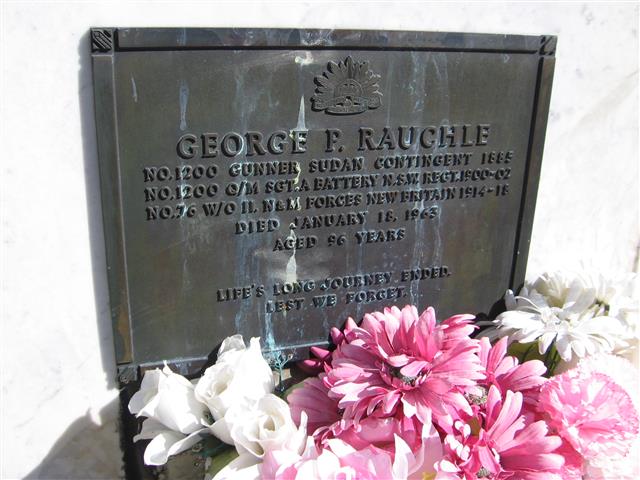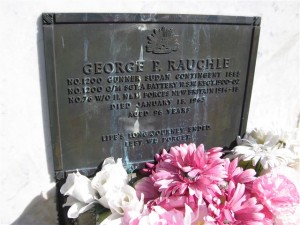George Patrick Rauchle marched for the final time in Orange on Anzac Day 1962. He was an old man; now in his mid-90s and with him he carried memories of his 27 years of service to Australia which spanned three wars, the Sudan, the Boer War and finally WWI.
George was the son of a German immigrant Auguste Friedrich Rauchle and Irish lass Honor Ann O’Halloran who married in Holy Trinity Church, Orange, in 1861. George was born in Emu Plains in 1866, where he father worked on the construction of the bridge across the Nepean River. The family returned to Orange when George was two years old, and George was to remain in Orange for the rest of his life.
George attended school in Sale Street and his first job was as a cashier with Nelson Brothers. He was subsequently apprenticed to John McCutcheon Paul as a saddler, and later worked for the coachbuilder, Michael Kinealy, and blacksmith Richard Venables. During his time with Venables George assisted with the construction of the stone and iron fence that still surrounds the Orange Courthouse.
Civil unrest in Sudan in the 1880s saw an 18 year old George enlist in the NSW Voluntary Contingent at Victoria Barracks. The contingent, comprising 522 men, 24 officers and artillery battery of 212 men, sailed on 3 March 1885. This was an historic occasion; it was the first time soldiers in the pay of a self-governing Australian colony were to fight in an imperial war. They joined forces with British troops at Suakin and marched as a whole to Tamai 30 kilometres away. While the horror of war lay all around them in the destroyed village of Saukin, they themselves were only involved in minor skirmishes. Thereafter they were mainly involved in building the railway from Suakin to Khartoum and the contingent returned to Sydney on 19 June 1885.
When the Boer War broke out in 1899, George was a member of the permanent artillery unit. They left Sydney in December 1899 on the Warrigal. When the regiment arrived in South Africa they were divided into small groups. George went to Orange River and then Upington with General Settle’s column. At Upington, George was put in charge of rations and forage distribution. Although he was taken from his rightful regiment George felt he “wasn’t doing too badly for an Australian”. This was in a time when conditions were harsh. Both soldiers and horses had to tolerate extremes in heat and very little food. Nearly half the casualties died from disease or starvation.
On 2 November 1914 George, now aged 48, again signed up to fight, this time in WWI. He was part of the 3rd Battalion Australian Naval and Military Expeditionary Force. This was a group of approximately 2,000 men who, after the outbreak of WWI, were sent to seize and destroy German wireless stations in the German section of Papua New Guinea. His WWI war papers state that on 9 September 1915 he was promoted to the rank of Warrant Officer whilst still doing the duty of a Master Gunner. He was invalided back to Australia via SS Te Anau on 6 December 1915.
George married twice and had five children. He was a foundation member of Orange sub-branch of the RSL, and its president in 1926, and was active in the Orange branch of the Voluntary Defense Corps during WWII. He worked for Orange Municipal Council for 17 years as caretaker of the Wade Park tennis courts until his retirement in 1948.
When George died in 1963, he was the only surviving member of the Australian forces sent to Sudan. He had seen Orange grow into a thriving country town. His decorations included 1914/15 Star, British War Medal and Victory Medal, plus medals from the Sudan and Boer Wars.
The Central Western Daily dated 19 January 1963 which records the very public funeral of George Patrick Rauchle states that E Company 2 RNSW Regiment escorted his cortege down Summer Street and past the Cenotaph for the last time. Members of the RSL conducted the graveside service and sounded The Last Post and Reveille.
George was laid to rest next to his parents and other family members in Orange Cemetery. He is commemorated on the Holy Trinity Church Orange Honour Roll.
George’s son – Frederick Norman Rauchle – also served in WWI. A granddaughter – Dorothy Lillian Marsh – served in WWII.
* Sharon Jameson, 2016


